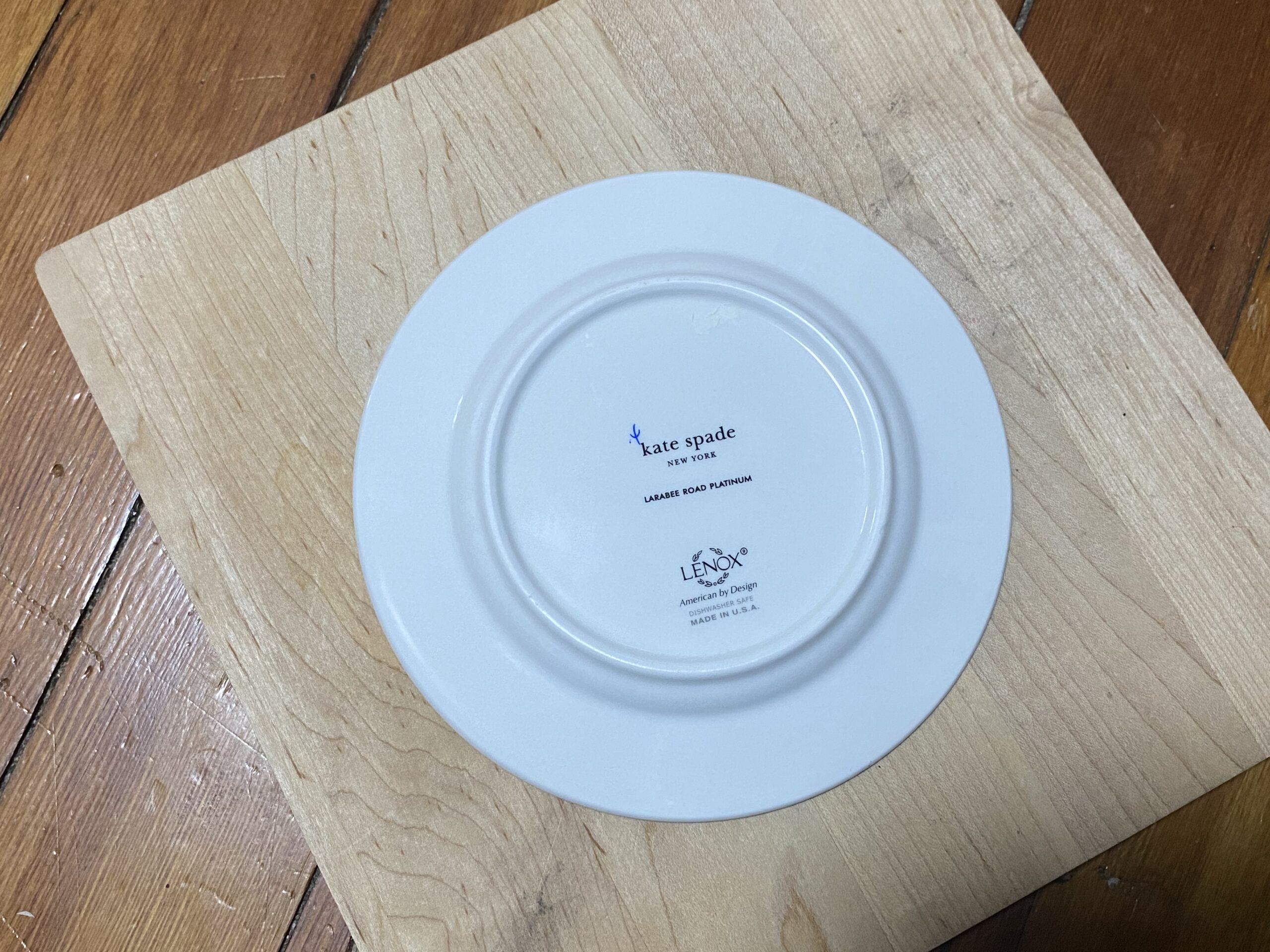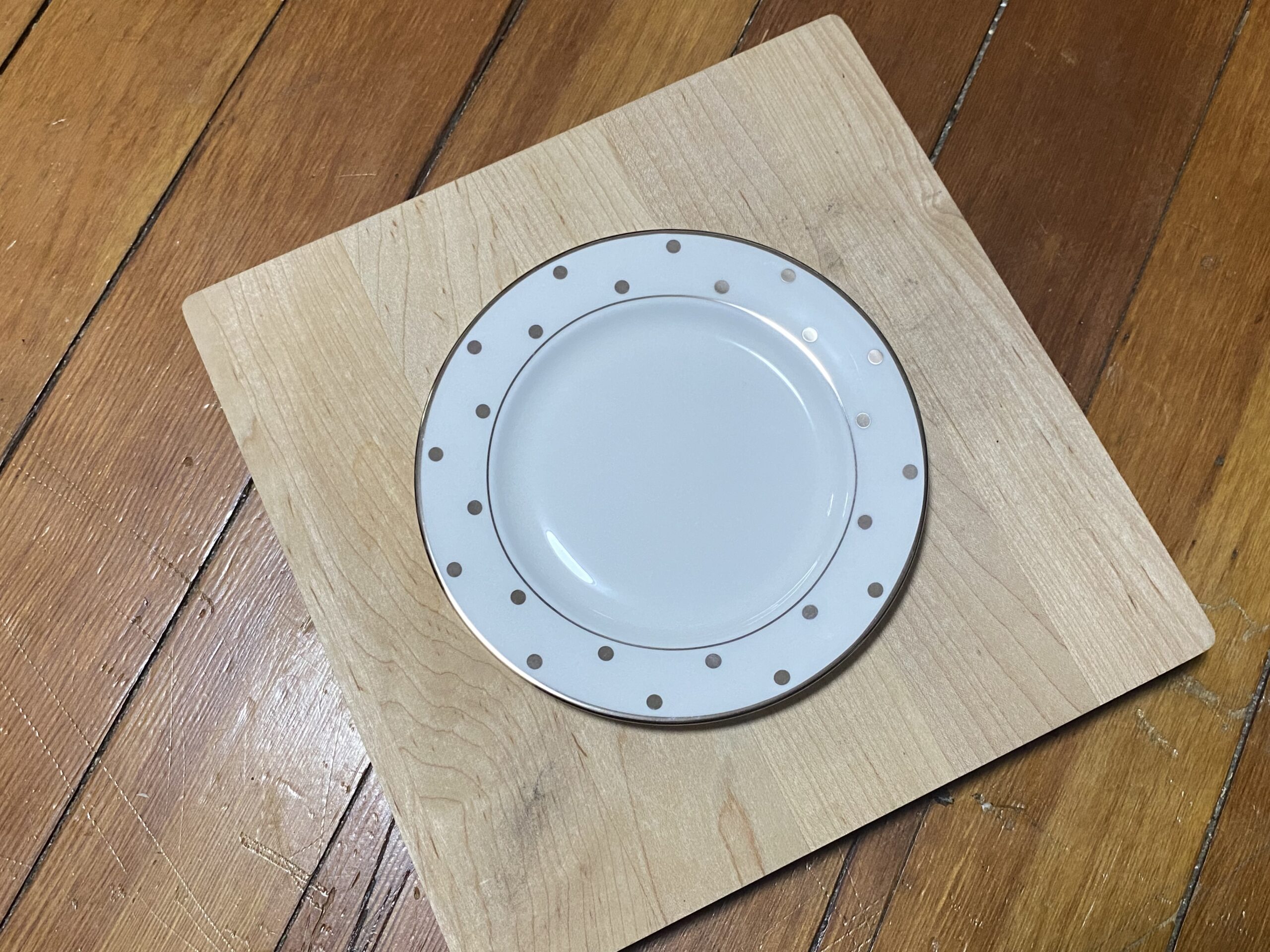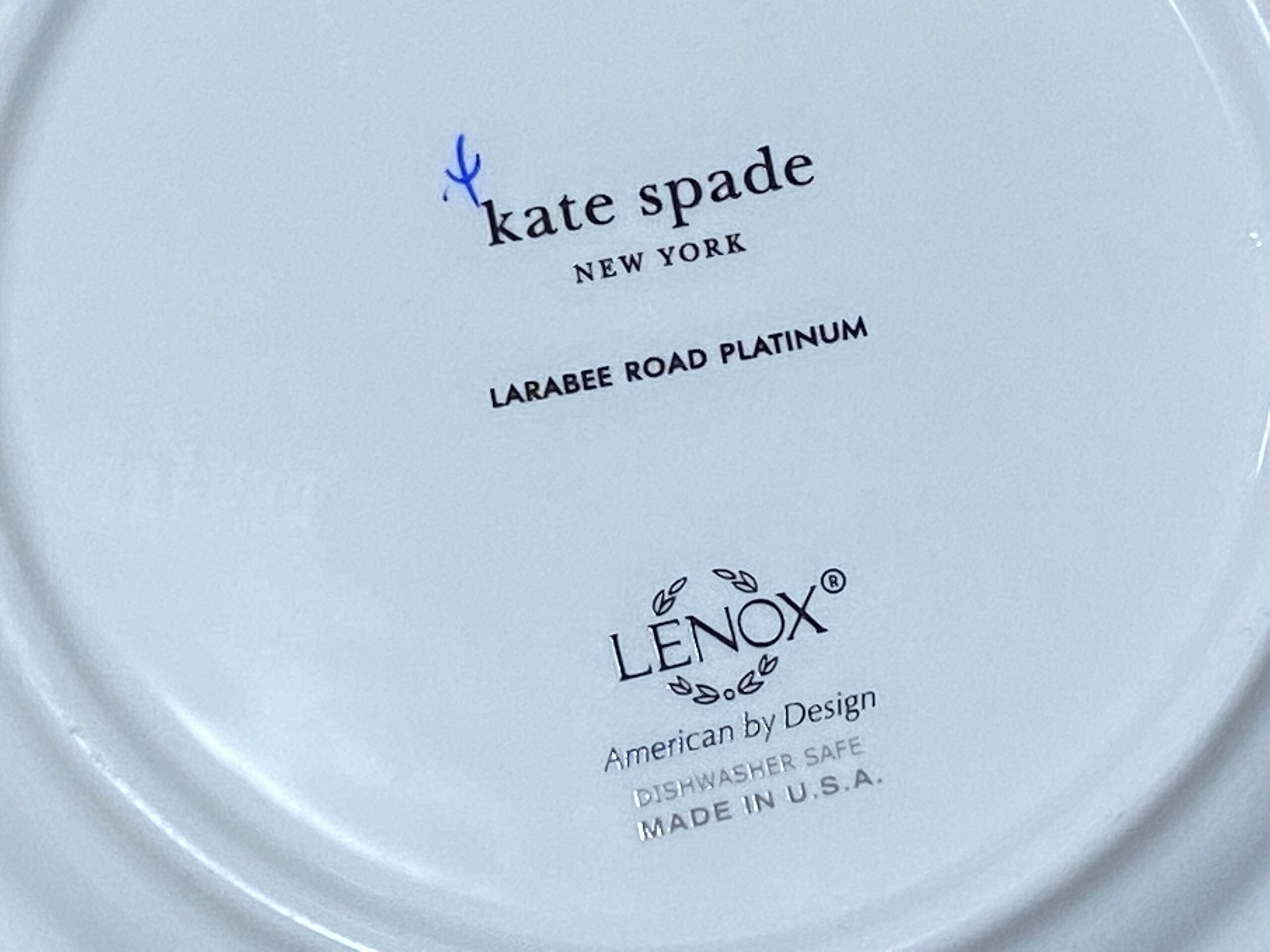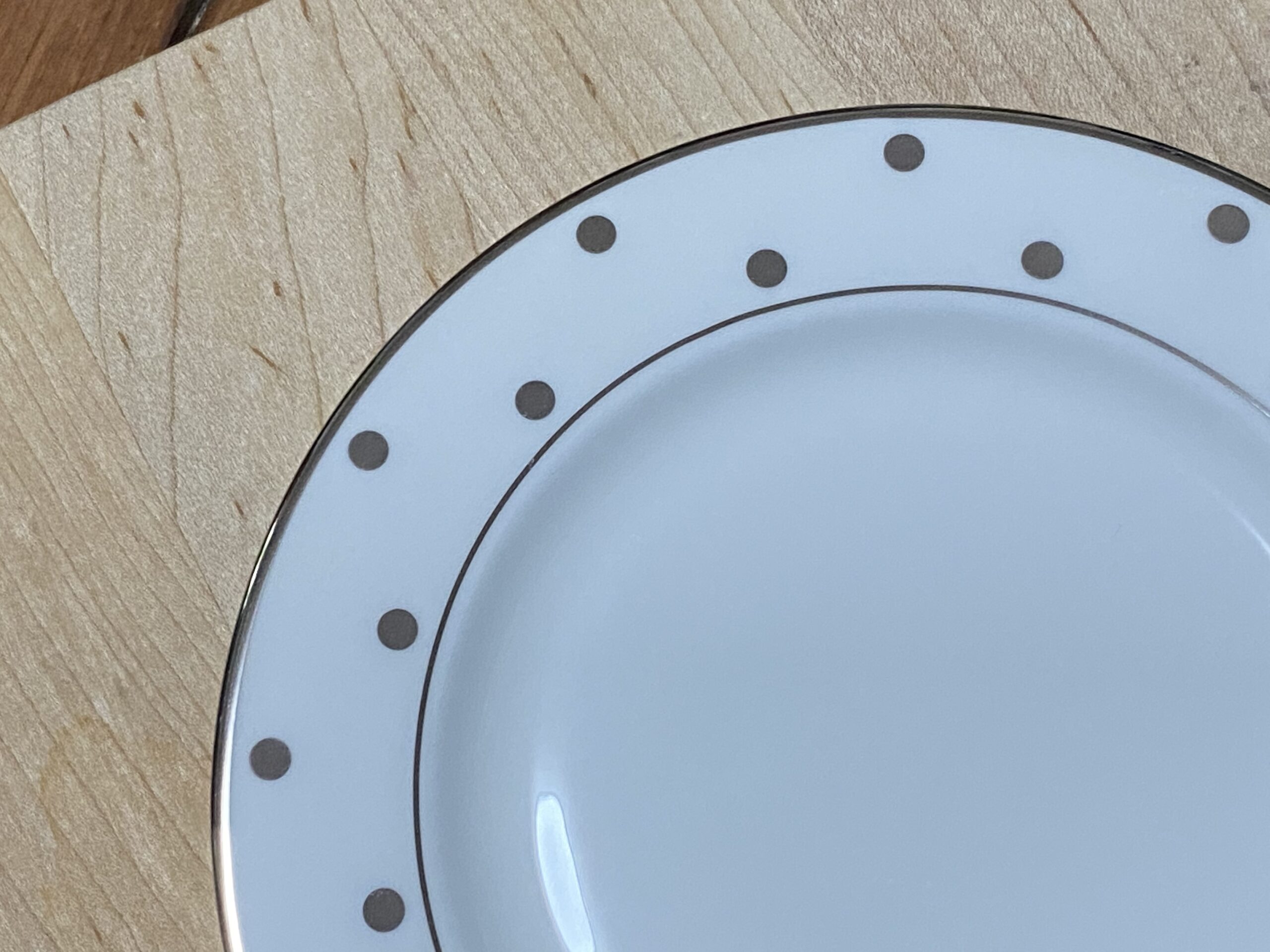Kate Spade Larabee Road Platinum pattern china dish (by Lenox): 49 ppm Lead on the center of the food surface (safe by all standards) — but 3,985 ppm Lead on the BACK MARK (!)
Published: Tuesday — July 5, 2022
The food surface of these dishes is considered to be “safe by all standards.” Although they did test positive for trace levels of Lead (at 49 ppm), which is below even the lowest of the current CPSC regulatory limits — of 90 ppm Lead (set for the paint, glaze, or coating of items intended for use by children).
But what about the back mark??
In my home, we keep a pretty strict “no Lead in the kitchen” policy — so I would not use these with my family (even with the low level of Lead on the food surface), primarily because the level of Lead in the back mark is so absurdly high.
While this might be considered (by some people) to be merely a “political” distinction (vs. a health and safety distinction), my stance on this is rooted in the consideration that Lenox is now using Lead-free glazes for the food surfaces of their modern/ newly manufactured dishes — so there no defensible reason for them to use neurotoxic Lead elsewhere on their dishes (even if it is currently 100% legal, which, unfortunately, it still is). (FYI — there are, in fact, also health-related implications when it comes to the back marks/logo marks of dishes testing positive for high levels of Lead. While it is possible the Lead on the back mark might never wear, that possibility diminishes with the regular handling, washing, microwaving, stacking, and daily use of dishes like these — so even though the potential for these dishes to be the cause of micro-particulate Lead wearing off into your kitchen environment may be low, the potential is certainly still there and as a parent of kiddos with neuro-cognitive deficits and other health impairments as a result of their Lead exposure, this is not a risk I am willing to take. The impacts of Lead exposure are cumulative — and, in my opinion, we should avoid all Lead-containing products whenever possible. You can read more about that, here.
What can be done about things like this?
I think dishes like this can be used as an example of communicating the demands of consumers to manufacturers. We can return items like this, and ask for Lead-free alternatives (since we know that the company cannot — at this point — respond by saying they are unaware of the concern for Lead glazes in dishware, especially given they have already made the jump to Lead-free glazes for the food surface of their dishes). In many cases, actually, the fact that the back mark of a dish like this tests positive for very high levels of Lead is a matter of a lack of oversight/ a lack of any consideration of the logo mark. These days, companies seem to (finally!) be putting a lot of thoughtful intention and choice into their surface glazes and substrate content — but they just haven’t yet made the leap to putting that same level of consideration into their logos and back marks… because (in many ways) these elements are an afterthought to the product’s design (not a primary component of the design). I find this even to be the case with companies that are intentionally advertising and marketing/promoting their dishware as “Lead-free” (they still often tend to have Leaded back marks — because the QA person in charge of the back marks is to likely be someone other than the person in charge of making sure the surface glazes are Lead-free).
In the end, it is your choice.
Some Lead Safe Mama readers are thrilled to learn that the food surface of a dish like this is “safe by all standards” and they are willing to overlook the Lead concerns in the logo mark — or “just on the exterior (non-food-contact-surface)” of a dish or vessel. Others like myself, are a little more strict and choose not to allow things like this in their home. In the range of possibilities for toxicants that can be present in dishes, this is definitely a “safer” choice in many perspectives (certainly much better than most of the other dishes — some particularly egregious vintage items — I have written about this week!), but it is important to be clear that it is most definitely NOT a “Lead–free” choice. This is a piece I wrote that discusses — at greater depth — the concern about the issue of Lead found in a kitchenware product being “only on the outside.”
Below are the full test results for the Kate Spade (by Lenox) dish pictured.
Reading #1) White center of the food surface of the plate
60-second reading
- Lead (Pb): 49 +/- 11 ppm
- Cadmium (Cd): non-detect
- Tin (Sn): non-detect
- Mercury (Hg): non-detect
- Selenium (Se): non-detect
- Barium (Ba): 312 +/- 32 ppm
- Chromium (Cr): 482 +/- 290 ppm
- Antimony (Sb): non-detect
- Nickel (Ni): 104 +/- 52 ppm
- Copper (Cu): 67 +/- 26 ppm
- Zinc (Zn): 5,958 +/- 161 ppm
- Manganese (Mn): 364 +/- 173 ppm
- Zirconium (Zr): 949 +/- 25 ppm
- Indium (In): non-detect
- Iron (Fe): 1,954 +/- 161 ppm
- Bismuth (Bi): 117 +/- 14 ppm
- No other metals were detected in consumer goods mode.
Reading #2) Decorative silver-colored/platinum dots on the food surface of the plate
30-second reading
- Lead (Pb): 25 +/- 13 ppm
- Cadmium (Cd): non-detect
- Tin (Sn): non-detect
- Mercury (Hg): non-detect
- Selenium (Se): non-detect
- Barium (Ba): 296 +/- 34 ppm
- Chromium (Cr): 561 +/- 306 ppm
- Antimony (Sb): non-detect
- Nickel (Ni): 95 +/- 56 ppm
- Copper (Cu): 107 +/- 30 ppm
- Zinc (Zn): 5,845 +/- 169 ppm
- Zirconium (Zr): 916 +/- 27 ppm
- Indium (In): non-detect
- Iron (Fe): 2,151 +/- 177 ppm
- Platinum (Pt): 175 +/- 53 ppm
- Gold (Au): 933 +/- 71 ppm
- Bismuth (Bi): 123 +/- 16 ppm
- No other metals were detected in consumer goods mode.
Reading #3) Black back mark/logo mark of the dish
60-second reading
- Lead (Pb): 3,985 +/- 105 ppm
- Cadmium (Cd) non-detect
- Tin (Sn): non-detect
- Mercury (Hg): non-detect
- Selenium (Se): non-detect
- Barium (Ba): 283 +/- 35 ppm
- Chromium (Cr): 3,668 +/- 414 ppm
- Antimony (Sb): non-detect
- Nickel (Ni): 558 +/- 75 ppm
- Copper (Cu): 71 +/- 28 ppm
- Zinc (Zn): 4,703 +/- 142 ppm
- Zirconium (Zr): 734 +/- 23 ppm
- Iron (Fe): 4,954 +/- 253 ppm
- Vanadium (V): 985 +/- 652 ppm
- Platinum (Pt): 90 +/- 54 ppm
- Cobalt (Co): 1,434 +/- 123 ppm
- Bismuth (Bi): 87 +/- 20 ppm
- No other metals were detected in consumer goods mode.
For some inexpensive Lead-free dish ideas, check out this link.
For those new to this website:
Tamara Rubin is a multiple-federal-award-winning independent advocate for childhood Lead poisoning prevention and consumer goods safety, and a documentary filmmaker. She is also a mother of Lead-poisoned children (two of her sons were acutely Lead-poisoned in 2005). Since 2009, Tamara has been using XRF technology (a scientific method used by the U.S. Consumer Product Safety Commission) to test consumer goods for toxicants (specifically heavy metals — including Lead, Cadmium, Mercury, Antimony, and Arsenic). Tamara’s work was featured in Consumer Reports Magazine in February 2023 (March 2023 print edition).

Never Miss an Important Article Again!
Join our Email List











